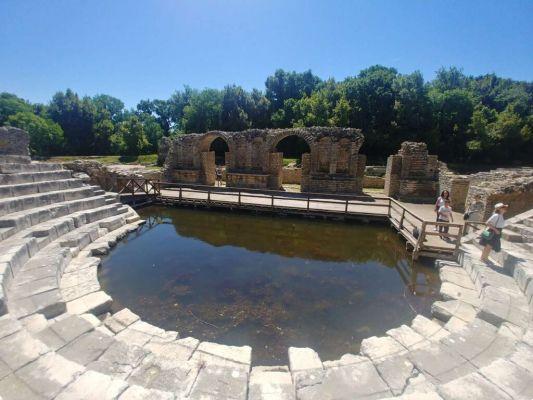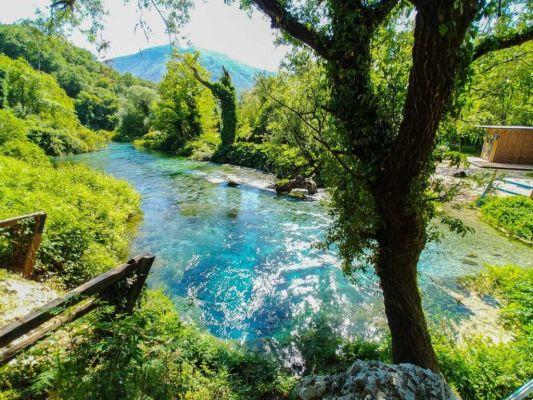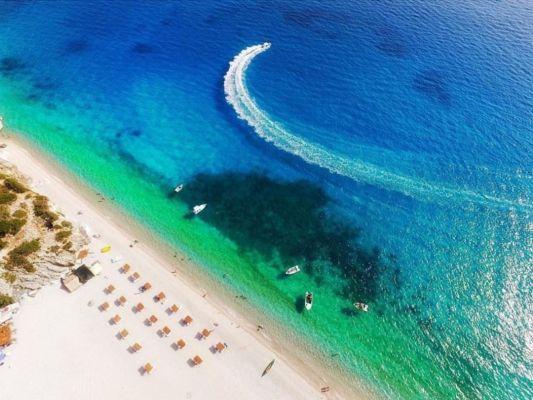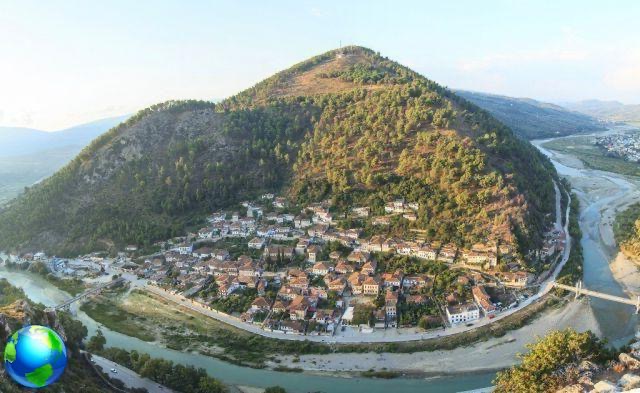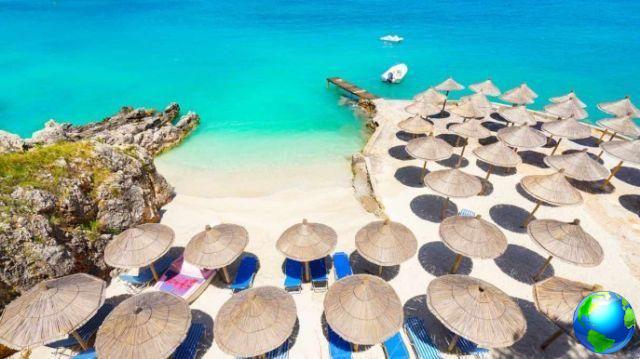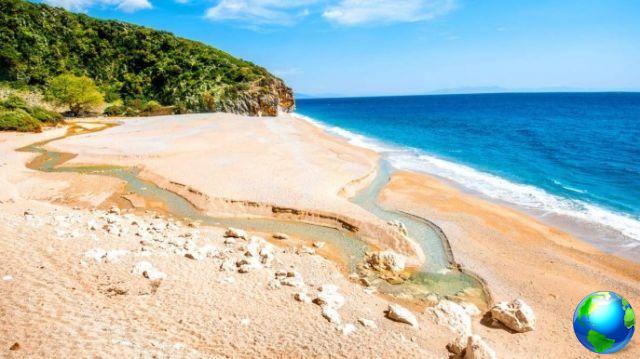On a trip to Albania one of the most beautiful and exciting stages is certainly represented by Gjirokastra (Gjirokastër in Albanian) also known as the stone city, for intensive use of silver colored limestone which gives the city its unique character.
Dominated by its castle on the Drina valley, Gjirokastra is a magical hill town boasting a 2500 year old settlement, incredible multi-story Ottoman fortified houses, some beautifully maintained, excellent regional cuisine and truly spectacular surroundings.
Wanting to investigate its past, Argicastro is also famous for having been one of the infamous political prisons of Albania and the birthplace of the ex dictator Enver Hoxha, whose house now houses the museo Etnografico di Gjirokastër.
UNESCO World Heritage Site since 2005 for its well-preserved center built by peasants during the period of the Ottoman Empire, a city where Greek, Roman, Ottoman, Byzantine and Sufi heritages merge, there are so many things to see and the city, perhaps more beautiful than Albania, it deserves a few days. Even if the initial intentions were to spend all the time on the coast or on the "Albanian Riviera".
If you have a day or two around here and are wondering what to see in Gjirokastra and how to make the most of your time in one of the most beautiful cities of Albania, this post will help you organize your days in the best way!
What to see in Gjirokastra in one day
You can visit Gjirokastra autonomously or if you prefer, you can do it with an Italian-speaking guide who, in one day, please wear comfortable shoes, will accompany you to discover the city and the most important places. This private tour can suit you and you can even choose the language you prefer.
If, on the other hand, you want to see the main places of interest in Gjirokastra on your own, here are the places that I advise you not to miss and that you absolutely must visit.
Gjirokastra Castle
The castle of Gjirokastër towers above the surrounding city, constantly reminding, as it is visible from any point of the city, of the greatness of the past. The result of constant work and reinterpretations lasting hundreds of years, the castle of Argicastro today, in addition to the well-preserved structure, houses pieces related to the resistance and to Western occupation.
Originally built in the XNUMXth century, today's castle looks different from the initial one thanks to the additions provided by the numerous Albanian political leaders.
The bases and the first defenses were created by the Despoti dell'Epiro, offshoot of the Byzantine government. Under Ottoman rule the castle was renovated and rebuilt reaching theroyal apex.
In 1800 the clock tower and the aqueduct were added.
In the 30s the re Zog I converted the fortress into a prison where to lock up the various resistance forces that operated in the country during his reign, adding a series of cells that can be visited. The prison continued to operate as a prison until 1968.
The castle complex also includes a museum that tells the history of the area (with information panels in English and Albanian), a weapons collections section and the old prison cells. In the internal corridors there are numerous tanks dating back to the Second World War outside you will come across a curious American fighter plane.
In this regard, next to the area there is an information panel that tells the story of how the jet della US Air Force arrived there, the two versions of the same story.
According to some rumors, in fact, it seems that the Albanian forces shot down the jet during the cold war (1957). Others believe that the plane was an American spy jet forced to land at Rinas airport in December 957 due to mechanical problems. The pilot forced to land returned to the United States leaving the aircraft in Albania. The real story is unknown but today this military piece is displayed in the grounds of the fortress.
Entrance tickets
The castle is open all year round (April to September 09:00 to 19:00, October to March 09:00 to 17:00)
- The entrance to the castle costs 400 leke per person
- Entrance for groups costs 300 leke per person
- Entrance to the museums costs 200 leke per person

Gjirokastra between legend and history
It is not known where the name of the city comes from, Gjirokaster. However, there is the legend that during the final siege of the city by the Turks, the principessa Argyro, sister of the feudal lord of the city, desperate for her people, rather than surrendering decided to throw herself, with her newborn son, from the cliffs of the fortress.
In fact, the castle is still today called 'the fortress of Argyro' which derives from this story.
However it seems that the name was mentioned in some Byzantine documents well before the Ottoman conquest, so the figure of the princess does not hold.
Another explanation is that the city takes its name from Greek word “silver” – argyrókastron – reference to stone walls, streets and roofs that shine like silver when it rains.
Another possibility is that the name derives from a clan originating in the region called Argjyri.
The cold war tunnel and the obsession with dictator Enver Hoxha's bunkers
The Cold War Tunnel Museum is an underground bunker that served as an emergency shelter in the latter part of Albania's communist era, i.e. between 1944 and 1990.
This bunker, but also all the other smaller ones distributed throughout Albania, is nothing more than a reflection of the dictator's obsession Albanian communist, Enver hoxha which, after Albania's break with the Soviet Union in the early 60s, feared a foreign invasion.
Il Gjirokaster cold war tunnel800 meters long and with 59 rooms in their original state, it was designed to house government officials in the event of a nuclear attack. Inside you can see the rooms for government ministries, interrogation rooms, party elite rooms, dormitories, energy production, cistern and kitchen.
La visit lasts about 20 minutes, a guide is mandatory, and the entrance is located near the Town Hall building, which once served as the seat of the Party Committee.
Admission costs 200 leke per person and can be visited from April to October from 9.00 to 18.00 and from November to March from 8.00 to 14.00.
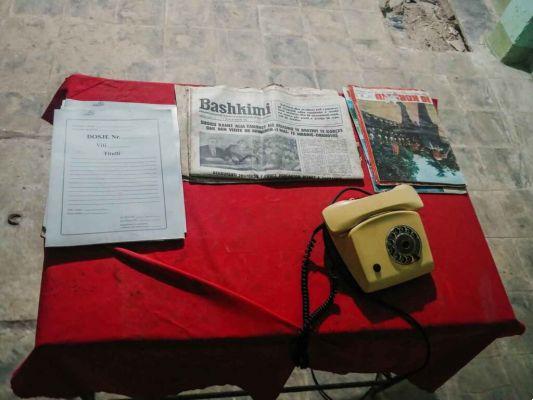
Typical Albanian house – Skenduli House
Among the many houses the Skenduli House, built in 1823, it was recommended to us by our guide not only because everything is still original, it is the house more authentic than Gjirokaster, but also because the owner, Nasip Skenduli, a descendant of the family, is an exceptional storyteller.
The house was confiscated during the communist period and had been transformed into the ethnographic museum. Returned to the owners in 1993, today it is one of the most beautiful and interesting to visit in the city.
The 9 fireplaces confirm that this was the richest house in Gjirokastra – the more fireplaces a house had, the richer the family that lived there – as if the 6 bathrooms, 12 bedrooms, 44 doors, 64 windows and 4 hamams weren't enough.
Many rooms are preserved in their original form as is the 17m fortified boundary wall. The guided tour has no timetable, lasts about 20 minutes, after which it is allowed to visit it independently, and a prior appointment is not required. If you take part in a guided tour, this among the other houses will most likely be the one you visit.
Casa Skanduli is located near the Ethnographic Museum, the home of the Albanian dictator Enver Hoxha, and the entrance costs 200 leke per person.
If you want to visit other traditional houses I suggest you take a look at this link which mentions the main ones in Gjirokaster.

The Ethnographic museum in the birthplace of the dictator Enver Hoxha
The ethnographic museum is located on the site of the former house of communist dictator Enver Hoxha. Although it was destroyed by fire, the house was rebuilt between 1964 and 1966 following a model of traditional houses of Gjirokastra, so not faithfully as it was before. The restoration was based on traditional elements copied from the most beautiful XNUMXth century houses in the city.
While being the birthplace of the dictator inside no reference to Enver Hoxha is found. and the purpose of the visit is only to show beautiful decorations with cultural artifacts, various household items, folk costumes and clothes, and various utensils.
The house is located in the Palorto district and the entrance costs 200 leke.
The bazaar of Gjirkaster
The Bazaar of Gjirokastra, called by the locals Pazar Neck, forms the center of the Old Town and its history dates back to the 17th century.
Little remains of that period since it seems that it was destroyed by a fire in the XNUMXth century. It was afterwards reconstructed following the same style for all the houses, with 2 or 3 floors, so as to make it homogeneous and picturesque.
The architecture of this bazaar is reminiscent of the bazaar in Korca which suggests that they were built at the same time, with the difference being that Gjirokastër had to adapt to the sloping streets making it quite unique.
Today's bazaar is very well preserved, on the first floor of the buildings there are souvenir shops, restaurants and bars and there are a few artisans left including a 300 year old oven in which to buy excellent bureks.

Gjirokaster Mosque
The Old Mosque is located in the Old Bazaar of Gjirokastra. This mosque is thought to have been spared destruction by the communists in the late 60s because cultural monument. In fact, the other twelve mosques existing at the time were all destroyed.
Although spared in those years it had been converted into a training hall for circus acrobats who used the high domed ceilings to hang their trapeze bars.
The mosque was built in the XNUMXth century as part of the Memi Pasha's plan for the Bazaar.
The octagonal building on the west side is used for the ritual washing of hands and feet before worshipers enter. According to religious custom, women pray separately from men and have their own entrance. The area under the entrance porch was occupied by shops through which money was raised to support the maintenance of the mosque. Today the area under the portico is occupied by a very nice bar/restaurant.
Access to the minaret, which has 99 steps and represents the 99 names of God given in the Quran. Nearby you will see a yellow building that looks a bit like a mosque with its domed roof. This two-story octagonal building, built in 1727, was a only Bektashi, Sufi Islamic brotherhoods of the Bektashiyya, was closed during the communist period and today is a madrasa (Muslim school).
The mosque in the Old Bazaar is open every day. Admission is free and the best time to visit is about 15 minutes after the call to prayer when the imam is present.

Where to sleep in Gjirokastër
Gjirokastra is divided into the old part, on the hill, and the new part, at the base of this, nothing particularly attractive. If you are looking for a hotel or hostel in the city centre, my preferences go to the Kondra hotel, a stone's throw from the Bazaar with a beautiful bar/restaurant with a view and rooms in a typical traditional style. Elegant yet simple, it has city center and spacious rooms.
If you travel in the summer, a hotel with a swimming pool could be right for you, since it can get very hot in Gjirokastra, in this case I suggest you take a look at the Hotel Praga. Central, very nice rooms in a traditional style, spacious and spotlessly clean.
Visit Gjirokastra in a day from Saranda
If you don't want to sleep in Gjirokaster but you do visit it in the day from Saranda, which is very feasible, unless you have a car I recommend you take a tour that usually includes other stops along the way, such as the Blue Eye or the Benja thermal baths near Permet.
The costs are very affordable, like everything in Albania, and so you are sure to be able to see all that the area has to offer.
Among the tours that I find most interesting, I point out the tour to Gjirokastra and the Benja thermal baths (about €70 euros) and the tour to the Blue Eye and Gjirokastra (€89 euros). Both can be booked with an Italian-speaking guide and are private, therefore flexible with times and stops.
How to get to Argikastro from Saranda and Tirana
Gjirokastra is along Albania's main highway and generally any bus going to Tirana and Saranda, as long as they're not taking the coastal road, is fine.
To leave the city however, remember that most buses leave from the Kastrati petrol station on the main road. There is also a daily service to Berat, Korce, Durres and Vlora. Please confirm your departure time with your hotel.
If you have a car, consider about 1 hours from Saranga, so you can visit the city even in one day, and more than three hours from Tirana.
How to get to Gjirokaster from Tirana
There are six daily buses that connect Tirana to Gjirokastra starting at 11 in the morning. The journey takes about 3 hours and costs 1.000 lek (8 euros).
How to get to Gjirokastra from Saranda
From Saranda there are several daily buses that reach Gjirokaster and then continue to Toiana. The journey takes just over an hour and costs 400 lek (€3,20). All buses leave on the highway and from here the old city can be reached in 30 minutes on foot (it's all uphill so if you have a backpack or heavy suitcases I suggest you take a taxi which will take you up in 5 minutes).
Visit Argikastro in Albania - Frequently Asked Questions
How many days to stay in Gjirokaster?
One day is enough to visit all the most important places in Gjirokastra but I recommend to stay at least 1 or 2 nights to also be able to visit the surroundings and maybe see even more historic houses.
What is the most beautiful road to reach Gjirokastër?
If you want to reach Gjirokastra from Tirana I suggest you do it following the coastal road, the Albanian Riviera, you have to drive to Gjirokastra up to Vlora, along the Llogara pass, driving through Dhërmi, Vuno, Himarë, Borsh, Lukovë and finally Saranda.
From Saranda take the internal road towards Gjirokastra. This route takes about 4 to 5 hours more than the journey from Tirana on the north-south highway.
If you are coming from Eastern Albania or Macedonia, I strongly recommend that you follow the much slower but truly spectacular route that passes through Pogradec, Korçë, Ersekë, Leskovik, Përmet, Këlcyrë Gorge and Uji i Ftohtë Tepelenë.
Can I visit Gjirkastra in a day from Saranda?
Yes of course. Saranda is approximately 1 hours' drive from Gjirokastër. If you don't have a car you can also take the bus, but I recommend you sleep at least one night, or you can take part in a day tour.
How far is it from Syri i Kalter to Gjirokaster?
Syri i Kalter (the blue eye) is one of the most beautiful places in southern Albania and an easy day trip from Gjirokaster or Saranda on the way to Gjirokaster.
If you are leaving from Saranda you take the bus to Gjirokastër, inform the driver that you want to get off at Syri I Kalter. From the stop it will take you about 30 minutes on foot, 2 km, to reach the site, the route is well signposted. From Gjirokaster the Blue Eye is about 37 km which can be covered by car in about 50 minutes. Also in this case, if you travel by bus, ask to get off at the beginning of the route.
When does the Gjirokaster International Folklore Festival take place?
Considering the small size of the historic center and the heat of the summer, perhaps July and August are not the best months. But if you are in Albania in May remember that every 5 years (2020 would have been the year) in this month the National Folklore Festival, an arts festival which has been taking place at Gjirokastra Castle since 1968 and which is considered the most important event of Albanian culture.




